More musical Tesla coils (And a musical saw)
June 24th, 2007Since my last post, I’ve discovered that itseems like there quite a few musical Tesla coil videos on youtube. This is probably due to the eeeeeevil works of The Geek Group.
I’ve picked three of my favourite videos.
This one is a comprehensive explanation to the inner workings of a musical Tesla coil. As it seems their version takes an audio signal, reduces it to one bit in depth and sends it as a modulated carrier signal to the coil.
Well, I’d like to see some other signal formats to see if it can change the audio quality. I can think of at least two ways:
- You could send the signal as a PCM at the coils resonating frequency. (Same frequency, different pulse width)
- You could create a PCM at a lower frequency than the resonating frequency and then modulate the resonating frequency by that PCM
- Another idea that I personally find compelling is that you could ring modulate the carrier by the input signal and power the coil with the result. That would be interesting!
(Three items? I told you I could think of at least two ways)
I like the tune he’s playing in this one, and also the snap that every new note makes, gives the sound a sense of dynamics.
Another one from The Geek Group, the Tetris theme again, this time polyphonically played by two coils.
From one rare sound source to another: I recently found a digitalization of a rare vinyl recording from 1963, given out as an encouragement to the salespeople of Sandvik. Apart from a short speech in both Swedish and English to the salespeople, there are threee songs by Moses Josiah, played on a musical saw. Which is simply a saw held like a violin and played. It’s not a hard metallic sound, but rather a soft resonant sound, which reminds of that of a theremin. (Which is of course part of the reason I decided to blog about it)
Watch out for the next post, having fun with search engines.
Alternative speakers made of flames, Tesla coils, fans and air!
June 20th, 2007Did you think that a speaker must consist of a vibrating membrane? Wrong! There are various other methods of creating sound. All it takes is something that makes the air vibrate. Or rather strictly speaking, anything that makes your eardrum vibrate. It’s possible to create an audible sound by vibrating the skullbone, and in turn the eardrum and the rest of your ear’s hearing mechanisms. Such headphones do exist and are being sold primarily to swimmers.
But even on land there are various more or less weird ways of making the air vibrate. The reason I decided to finally write this post is because of a cool link that Tiago (xernobyl) sent me. And with or without his knowledge, I’m a sucker for Tesla coils.
It’s a video of a speaker consisting of a Tesla coil. Tesla coils are generally used to produce high voltages that create sparks in the air, mad scientist style. A tesla coil should be feeded with an AC current in order for it to do its job, and this guy came up with the idea of modulating the carrier frequency to produce sound.
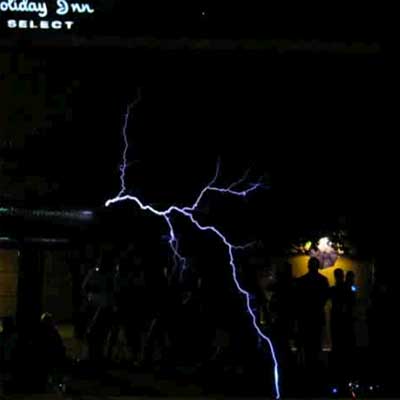
(Click the image to see the video)
It seems like the sound has a bit-depth of 1-bit, making it ideal for chiptunes, and sure enough in the video showcase he played both music from Super Mario Bros (The underground theme) and Gameboy Tetris Type A music. There was also a first tune in the video that I don’t recognize. If you readers have a suggestion, tell me.
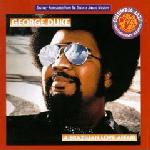 As a side note. The Super Mario Bros underground music seems to be very much inspired by a riff from George Duke’s 1979 record Brazilian Love Affair (From the first song, which shares its name with the album) I haven’t listened through the whole album for more possible sources of inspiration for Koji Kondo.
As a side note. The Super Mario Bros underground music seems to be very much inspired by a riff from George Duke’s 1979 record Brazilian Love Affair (From the first song, which shares its name with the album) I haven’t listened through the whole album for more possible sources of inspiration for Koji Kondo.
However… I’d like to have on of these! I’d hook it up with MIDI or something and make it a full fledged synth. One of the first things that I’d try to do is to add polyphony. Since the modulation in question is probably only a simple PCM, I’d try to increase the virtual bit depth, so to speak. Two or four square waves isn’t too much to ask for, right?
The Tesla coil link also reminded me of another thing I’ve been planning to post for some time. I’ve found a 1970 magazine about technology, and one article caught my attention. It was about one of those crazy inventions that never left the drawing board because for reason or other.
What I found was an article about a so called flame speaker. In some weird way it uses a speaker to amplify a sound. The scanned article is in Swedish, but Google has (at least) two more useful links, with scans from English magazines from the time.
http://www.swtpc.com/mholley/PopularElectronics/May1968/Flame_Amplification.htm
http://www.4×4pride.org/Flame/Docs/FlameAmp/FlameAmp.html
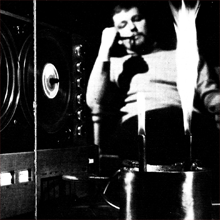
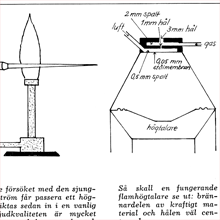
Click images for full article scans (in Swedish)
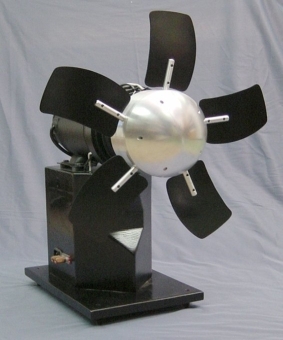 I’d like to build a flame amplifier/speaker at some point. But a fair guess is that the bass response is pretty bad. What to do about that? Just go buy a sub woofer?
I’d like to build a flame amplifier/speaker at some point. But a fair guess is that the bass response is pretty bad. What to do about that? Just go buy a sub woofer?
Not me! I’d complete it with a Rotary Woofer. In simple terms you could say that this is a fan that pushes the air back and forth, and so creating the sound.
So for the last onconventional type of speaker. It’s called a bumbimagi… No it isn’t, RastaMahn, STFU and get a life. It’s the directional type of speaker. It works not by producing any audible sound itself. Instead it produces a beam of ultrasound, which is inaudible to humans. (But is audible and even painful for dogs, and can still damage human ears, but that’s another story) The ultrasound then gets distorted in the air which produces audible frequencies.
The effect is similar to what happens when you play two notes on an instrument with a certain interval. (I don’t remember which interval now) the tones create a subharmonic. This is a technique used primarily by xylophonists. In a more controlled form the effect can, as mentioned, be used to create directed sound. The sound audible to humans is only audible within the pillar of air, defined by the direction of the speaker.
The product is being sold by the company HoloSonics, and they also have a little more information on the technology.
This post also comes with a couple of bonuses, things that I happened to find or do during the research for the post.
Here are some more scans from the Swedish 1970 magazine with article about flame amplification. (Flamhögtalare in Swedish)
The magazine is called “Tekniken idag” (Technology Today) which seems to be a special issue of “Tekniskt magasin” (The Technology Magazine)
Cover (Omslag)
The Computer, quickwitted, but dumb, spread 1 (Datamaskinen, snabbtänkt men dum, uppslag 1) - An article from back then about computers.
The Computer, quickwitted, but dumb, spread 2 (Datamaskinen, snabbtänkt men dum, uppslag 2) - Contains an image of a 1970 light pen and big big memory grid from the same year.
“Elmar” has the first artificial brain (”Elmar” har den första konstgjorda hjärnan) - An article about father of today’s robotic vacuum cleaners. However, “Elmar” is very stupid, it only uses one photocell to back off it comes to close to something… And that’s all it does, I think.
There are also a few more retrospective articles about astronomy, satellite spionage, supraconduction, the Loch Ness monster, PCMI microfilm, Hikari, (ひかり, the world’s fastest train at the time) an article about the future of television, (Amazingly mentioning flat TV’s) a test of a car PA, an article about Jules Vernes, and a collection of articles about space, which was the theme of the issue in question. There were also a few articles about cars and motor cycles that I didn’t find interesting enough to mention. (And whose contents are probably outdated, even from a retrospective point of view)
I can scan any of the articles mentioned, at request.
The other bonus is an album containing the complete sound track of Super Mario World, played on (mostly) acoustic instruments. Normally I tend to think that video game covers on traditional instruments tend to sound like shit, but this guy manages to do it in a proper way. The album has a professional touch to it, kind of like how Nintendo would do it to paraphrase the classic game in one of their newer titles.
So, check it out.
![You suck at protoshop. No, you [i]really[/i] oo.](http://blog.gg8.se/images/you-suck-at-photoshop-you-really-do-your-awful.png)


